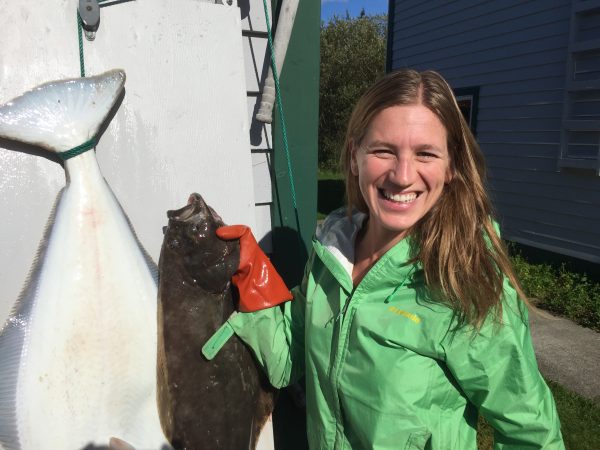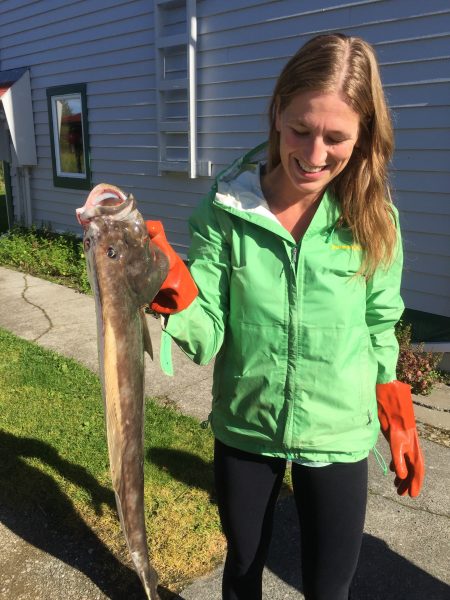Fishing, babies and gender in Alaska
September 18, 2017

Marysia Szymkowiak has studied fisheries for the last decade. But when her son was born earlier this year, Szymkowiak’s view of the world shifted, as did the focus of her research.
A social scientist at the Alaska Fisheries Science Center in Juneau, Szymkowiak had previously studied topics like the pros and cons of limited entry, individual fishing quotas, and other fishery management regulations. She’s a former Alaska Sea Grant State Fellow with NOAA Fisheries who reviewed impacts over 20 years of moving commercial halibut fishing from a derby-style enterprise to one based on quota shares. The fellowship led to her current job.
Szymkowiak’s interdisciplinary training in social sciences allows her to use large data sets and methodologies to collect socio-economic information to analyze fisheries, publish findings and write reports. Her doctoral thesis is called “The Costs and Benefits of Community Protection Measures in the Pacific Halibut Individual Fishing Quota Program.”
With the arrival of her baby in January, Szymkowiak started focusing more on family life. Given her professional research interests, the new mom grew more interested in knowing how fishing rules, prices and environmental changes can affect Alaska families who work in the industry, particularly women.
“This is a missing gap in our knowledge base,” she told Alaska Sea Grant. “We conduct a lot of research looking at individuals or communities and how they are impacted by fisheries management. But I think there’s an intermediary step of fishing families that’s often overlooked.”
Szymkowiak is working on a research project to document, among other things, how roles shift within Alaska fishing families when new rules take effect or when babies arrive.
“When I became a mom in January, it transformed the way I approach my research. I wanted to learn more about what kind of roles women have in fishing families. I’ve heard that a lot changes when kids come into the picture,” Szymkowiak said.
Alaska fisheries have undergone many regulatory, social and economic changes in recent decades. As an example, Szymkowiak said the move to catch shares in some fisheries has made fishing safer and has allowed for children to be brought onboard in some cases. But it has also made fishing seasons longer and that sometimes leads to conflict with those charged with taking care of young kids.

To get first-hand perspectives from people working in fishing, Szymkowiak recently conducted workshops in Southeast and Southcentral Alaska. Attending the scoping meeting were fishermen, fishermen’s spouses and others involved in the state’s multi-billion-dollar fishing industry.
“We try to target a pretty wide audience. We have had crabbers, trollers, shrimpers, skippers, deckhands, people doing paperwork, families who do shore-based fishing,” she said.
Szymkowiak asks lots of questions, gets people talking, and then goes back to the office to crunch data. She is employing both qualitative and quantitative methods, like panel data analysis, to examine changes in fishing family dynamics and women’s participation in Alaska fisheries.
She heard a lot during the workshops about how changes in salmon prices, for example, can lead to marital problems. Szymkowiak also said there was a lot of discussion about “the evolution of gender roles in Alaska fisheries and the kind of fluidity those gender roles have.”
Part of the research involves a quantitative look at the number of female permit holders and how that has changed over time. She heard from a number of young women interested in making a career in fisheries. But they expressed a common concern, often called the “graying of the fleet.” In other words, it can be hard for newcomers — regardless of gender — to enter commercial fishing because of the high cost of permits, coming up with enough cash to buy a boat or individual fishing quotas, and other hurdles.
Szymkowiak expects to conduct more workshops this fall and produce a report by year’s end or early 2018. She’s working with Sarah Marrinan, an economist with the North Pacific Fishery Management Council, on the project.


